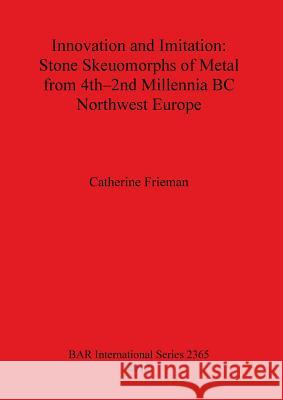Innovation and Imitation: Stone Skeuomorphs of Metal from 4th-2nd Millennia BC Northwest Europe » książka
Innovation and Imitation: Stone Skeuomorphs of Metal from 4th-2nd Millennia BC Northwest Europe
ISBN-13: 9781407309521 / Angielski / Miękka / 2012 / 244 str.
Innovation and Imitation: Stone Skeuomorphs of Metal from 4th-2nd Millennia BC Northwest Europe
ISBN-13: 9781407309521 / Angielski / Miękka / 2012 / 244 str.
(netto: 375,10 VAT: 5%)
Najniższa cena z 30 dni: 393,86
ok. 30 dni roboczych
Dostawa w 2026 r.
Darmowa dostawa!
In this study of prehistoric innovation, the author argues that a range of technologies and practices need to be considered in order to place innovation into the pre-existing social and technological systems in which it functioned and to assess the means by which it was accepted and valued. In particular the study focuses on how archaeological interpretations of stone objects and stone-working can help understand the adoption and continued presence of metal and metallurgy in prehistoric Europe. The author compares traditionally identified stone skeuomorphs - that is, meaningful imitations-of metal with their putative prototypes. Three separate corpora of these stone skeuomorphs have been identified: polished stone shafthole axes from the Netherlands and surrounding areas, identified as copies of perforated, copper axes; flint daggers from Jutland, identified as copies of bronze, metal-hilted daggers; and jet spacer-plate ornaments from the British Isles, Ireland and Brittany, identified as copies of hammered gold lunulae.
In this study of prehistoric innovation, the author argues that a range of technologies and practices need to be considered in order to place innovation into the pre-existing social and technological systems in which it functioned and to assess the means by which it was accepted and valued. In particular the study focuses on how archaeological interpretations of stone objects and stone-working can help understand the adoption and continued presence of metal and metallurgy in prehistoric Europe. The author compares traditionally identified stone skeuomorphs - that is, meaningful imitations-of metal with their putative prototypes. Three separate corpora of these stone skeuomorphs have been identified: polished stone shafthole axes from the Netherlands and surrounding areas, identified as copies of perforated, copper axes; flint daggers from Jutland, identified as copies of bronze, metal-hilted daggers; and jet spacer-plate ornaments from the British Isles, Ireland and Brittany, identified as copies of hammered gold lunulae.











